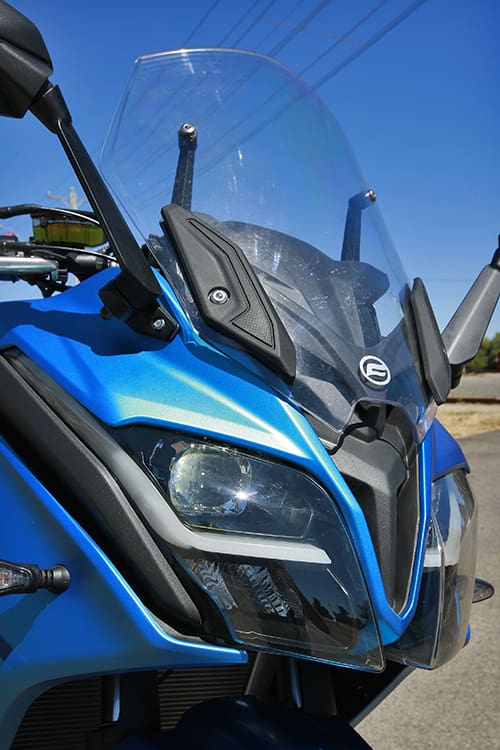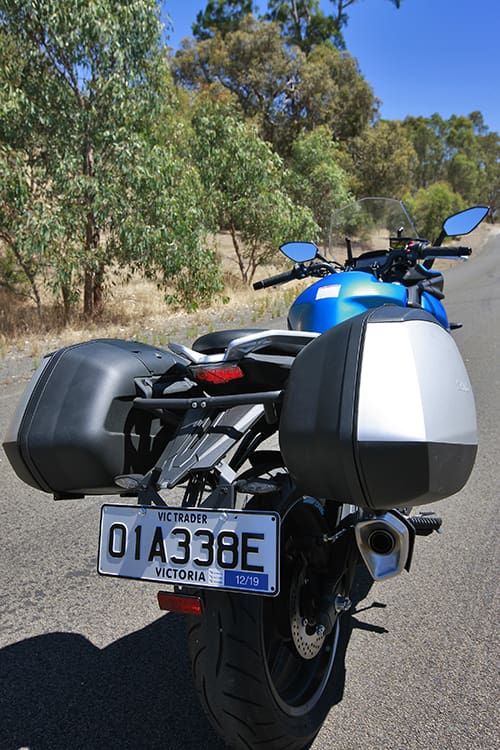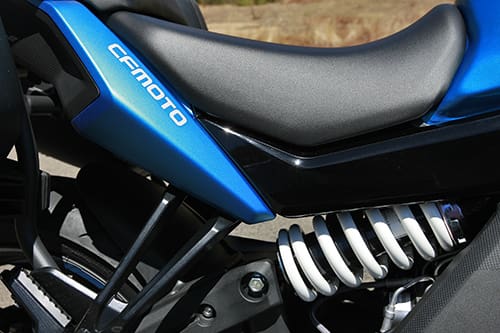Really, it was inevitable. Just like products of the Japanese industry half a century ago, Chinese motorcycles are increasingly no longer the cheap but not always cheerful products they used to be.
These days, they’re becoming more and more well-engineered and soundly constructed, with ever more attractive styling that’s no longer a crude imitation of Western design. But while industry giant Qianjiang has been a key player in moving this trend forward via its Italian Benelli subsidiary, another pioneer of engaging with overseas markets with more appealing and well-made middleweight models, is the much-smaller CFMoto.
In 2009, 20 years after the firm was founded, the company began development entirely in house of its own liquid-cooled DOHC 650cc parallel-twin engine as a platform for a range of different middleweight models. The naked 650NK was the first of these to be launched in China in 2011, reaching export markets one year later. The 650TK tourer came next, with export sales commencing in 2014, and 2017 saw the 650MT soft roader sold worldwide.
Now it’s the turn of the 650GT, which uses the same tubular-steel diamond frame as the other two models, with the same 650cc parallel-twin engine employed as a fully-stressed chassis component. After being downright impressed with the overall performance and especially value for money delivered by the 650NK nakedbike when I rode it back in 2012, and having visited CFMoto’s Hangzhou factory to see for myself the significant level of quality control imposed at each stage of its production cycle, I was looking forward to finding out how much its twin-cylinder platform had progressed.
The 650MT was the first CFMoto product to be Euro 4 compliant, so the 650GT follows in its tyre tracks by including twin-channel Continental ABS as standard, while once again being as affordably priced as its sister model.
With deliveries scheduled to commence later this year, Mojo is targeting selling the 650GT at $8490 (ride away), albeit excluding the pair of 32L panniers fitted to the test bike, costing an extra $650 for the two. That’s only a little more than the 650MT priced at $7990 with its less-protective bodywork, and stacks up well against the luggage-less Kawasaki Ninja 650’s $9999 (plus on-road costs) price.
But does the 650GT only give you what you’ve paid for, with corner-cutting compromises in quality and performance?
To source the answer I decided to repeat in just a single day aboard this sport touring model the same three-day long weekend tour of the Victorian Goldfields northwest of Melbourne in Victoria’s Central West that I’d undertaken five years ago on the 650TK tourer. This is a really rewarding ride, an accessible but enjoyable trip through glorious bush dotted with countless towns, remnants of the gold rush which actually kicked off Victoria’s statehood one and a half centuries ago.
This gave me the chance to ride CFMoto’s convincing attempt at building a mile-eating sport tourer through one of the most historic and scenic parts of the Australian continent.




And 502km in a single day in 34ºC temperatures was a stern test of any bike’s rideability, but especially a 650cc twin. Protection is excellent on the 650GT, thanks to the adjustable screen, which you must however use both hands to adjust via a pair of plastic wheels over a range of 50mm, although it would have been nice to have had a pair of handlebar guards, too.
The riding position is quite spacious despite the lower seat height, which actually makes you feel more involved than on the MT, and the lower seat coupled with the one-piece handlebar mounted on tall 100mm risers forming part of the upper tripleclamp delivers a fairly upright stance that’s really untiring. At the end of my long day in the saddle I joined up with some Aussie mates for a few beers, and had no numb-bum syndrome thanks to the well-designed seat. The mirrors are well placed, don’t vibe and give an excellent view behind you, too.
After riding through Ballarat, I began to explore the great biking roads linking Victoria’s picturesque towns like Daylesford and Castlemaine, Maldon and Maryborough, before eventually taking the Calder Freeway and heading back to Melbourne.
CFMoto’s same well-engineered 649cc DOHC eight-valve parallel-twin motor is fitted to the 650GT, complete with 180-degree crankshaft (so, one piston up/one down) and chain cam drive on the right of the cylinder block. Sure, this is essentially a Chinese copy of the Kawasaki ER6 motor, even down to the dimensions – but CFMoto owner Lai Guogui chose well in terms of which powerplant to copy in moving his company’s model range up the capacity ladder, and his engineers did a good job in executing it.
The GT version produces the same 52kW (70hp) at the crank at 8750rpm as in those other models, with identical peak torque of 62Nm at 7000 revs, and in its GT application this definitely felt even better-rounded than before.
Thanks to the single gear-driven counterbalancer and the hefty balance weights in the ends of the handlebars, there’s absolutely no vibration at any revs, right up to the hard-action 10,500rpm rev-limiter, and especially no tingles in the footrest or seat as you sometimes get at a constant cruising speed from comparable single-cylinder models, and even some twins. This makes the 650GT both pleasant and practical in freeway use, as well as ultimately untiring to ride, with the fruity-sounding exhaust note giving it heaps of character.
To obtain Euro 4 compliance, CFMoto switched to a Bosch ECU for its fuel injection package, matched to twin 36mm UAES throttle bodies (compared to the previous 38mm ITT ones), still with a single injector per cylinder. Besides improving fuel economy – always a consideration on a touring bike – reducing the choke size by 2mm has delivered some extra zip in terms of acceleration, which helped counter any performance lost in meeting the more restrictive Euro 4 norms. I got 355km from a full 19-litre fuel load in all kinds of use, which equates to 5.33L/100km, plus the red warning light gave me 30km of range, which was fortunately long enough to find a servo in Maryborough.
There’s a choice of three different riding modes on the 650GT, with the Rain map really softening the power delivery very noticeably, at the expense of any real sense of performance, although from previous experience with the 650MT I know that it does come in useful when riding along slippery surfaces – same as the single-stage Continental ABS which kicks in very effectively, if a little brusquely. But there isn’t much difference between the Sport and Touring modes also on offer, except that in Sport the motor is marginally more zestful in acceleration.
But the 650GT is a pretty flexible friend in either mode, thanks to the willing performance of its 650cc twin-cylinder motor. Thumb the starter button and this immediately comes alive, then settles to a high 1400rpm idle (perhaps chosen to counter the lack of a slipper clutch?), with a pleasing and distinctive rhythm emanating from the 2-1 exhaust, whose rather bulky silencer is carried quite low down on the right to leave space for the passenger footpegs.

Just as before, I found the parallel-twin engine to be torquey, free-revving and smooth, pulling pretty strongly with zero transmission snatch from 2000rpm on part throttle, and from 3000rpm wide open. There’s the same responsive power delivery, delivering a completely linear build of power all the way to that 10,500rpm revlimiter, and although it picks up revs a little faster from 5500rpm upwards, when there’s an extra spurt of engine acceleration, you wouldn’t really characterise this as a step in the powerband.
The six-speed transmission with chain final drive features a Japanese-developed FCC oil-bath clutch, making the 650GT a model of rideability thanks to its positive gearshift and light clutch action. This makes balancing the CFMoto at low speeds easy for riders of all levels of experience, with walking-pace, feet-up U-turns dead easy on a bike which has a very tight steering lock and is thus pretty manoeuvrable, thanks also to the well-mapped fuelling. There’s no trace of an abrupt pickup from a closed throttle – just a liquid response, which makes the bike seem so controllable. Though it is not particularly light for a 650 twin – 226kg (curb) without luggage – but with all liquids including a full 19-litre tank.
A great bike for beginners, it’s also enjoyable to ride fast, even if acceleration is determined rather than assertive thanks to the 13kg of extra weight it carries versus the 650MT, and 23kg more than the 650NK, even before adding the luggage. It’ll cruise all day at a relaxed 120km/h with the tacho needle parked at 5900rpm, a little more than halfway to redline, and 160km/h cruising is perfectly feasible, tracking dead straight with no wobbles even with those wide panniers fitted. At the ton, the engine is revving at 7200rpm while that quite effective screen shelters a 180cm-high rider’s helmet from windblast. Absolute top speed is 200km/h, but things get definitely stressed running that fast.
Torque peaks at 7000rpm and spread widely enough that there’s no point in revving it anywhere near the limiter. I shifted up at 8000 revs and found myself back in the fat part of the torque curve every time.
The 650GT’s Kiska-concocted riding position is super-comfortable, with the lower but still relatively plush seat slotting you into the bike rather than sitting on top of it, which makes you feel more involved than on the taller-seeming MT. There’s adequate space for a passenger on a taller separate seat flanked by long grab handles, while the rider’s footrests are positioned lower and further back than the MT, so you don’t feel cramped in a long day’s ride. The taper-section handlebar mounted on 100mm risers has just enough pull-back to deliver a comfortable, straight-backed stance. The switchblocks are a better quality than before, and after I complained about this last time on the MT, they’ve been reversed, with the light-switches moved to the more commonplace left handlebar.
The cockpit is pretty accommodating, and the TFT dash is a welcome addition whose pair of layouts each have a very readable analogue tacho with the large digital speedo set within it. There’s also a welcome and clearly visible gear-selected readout, plus a clock, a fuel gauge and I could only find a single trip plus an odometer. There’s a 12v socket on the right plus a USB socket on the left.
Handling-wise, I like the front suspension set-up – it is well-damped enough to iron out all but the worst bumps when taken on the angle, often at high speed. Thanks to the fairly wide handlebar there’s good leverage to help hustle the GT from side to side through a series of sweepers, where it feels really planted. There’s good feedback from the 120/70 front version of the pair of 17-inch Metzeler RoadTec tyres, which replace the Chinese-made CST rubber on the NK/TK duo.
Just as on the 650MT I wasn’t so happy with the cantilever rear shock, though, which didn’t seem very compliant and gave a rather choppy ride on the default settings. Without the necessary C-spanner I couldn’t experiment with preload adjustments, though the fact that the front is so satisfactory gives you confidence it’ll be reasonably effective.
But fitting the Spanish-developed J.Juan brakes – made in the firm’s Chinese factory – definitely gives the kind of superior stopping power lacking in the package previously fitted on the 650TK. These worked okay, but didn’t have the reassuring bite that the twin-piston axial front calipers now deliver in gripping the twin 300mm front discs, aided in doing so by the metal brake hoses fitted as standard. The 240mm rear with its single-piston caliper also gave an extra margin for carrying a passenger and/or luggage. You don’t need to squeeze the brake lever that’s five-way adjustable (same as the one operating the cable clutch) excessively hard to get them to work, and lever pressure remained constant even after successive hard stops.
The fact that CFMoto has fitted the Metzeler tyres, Bosch ECU, Continental ABS and J.Juan brakes indicates a welcome concern to deliver a bike fitted with branded components that’ll provide reassurance to export customers, all while maintaining that affordable price. But it’s a pity that on a bike likely to be used for longer journeys there isn’t a pocket in the bodywork for a phone or toll pass.
With apparently quite high build quality, and the strong identity delivered by Kiska Design, and especially the blue colour Gerald Kiska has chosen for the marque, the CFMoto 650GT is as capable, pleasing and as practical as any motorcycle costing twice the price. With many thousands of its 650 twins now having been sold in Western markets where they’ve proved durable and reliable, initial concerns about just how well they’d wear the passage of time has now been answered.
At last, a Chinese manufacturer seemingly more interested in quality rather than price, has developed a functionally excellent product offering exceptional value for money. Anyone thinking about buying a secondhand Kawasaki Ninja 650, let alone a new one, will soon have a very hard decision to make.
